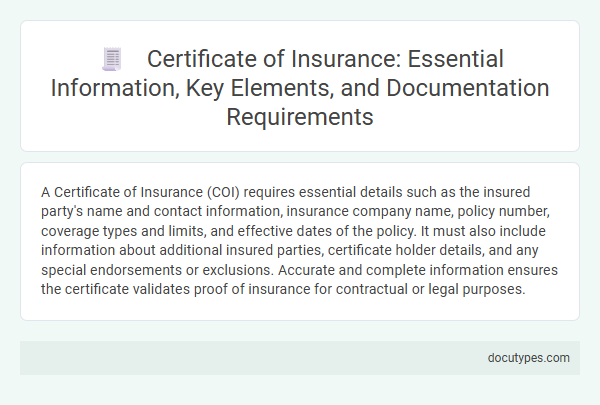A Certificate of Insurance (COI) requires essential details such as the insured party's name and contact information, insurance company name, policy number, coverage types and limits, and effective dates of the policy. It must also include information about additional insured parties, certificate holder details, and any special endorsements or exclusions. Accurate and complete information ensures the certificate validates proof of insurance for contractual or legal purposes.
Introduction to Certificate of Insurance
A Certificate of Insurance (COI) provides proof of insurance coverage for a policyholder. It summarizes critical details such as policy types, coverage limits, and effective dates. Understanding what information is required on a COI helps ensure accurate verification of insurance protections for all parties involved.
Purpose and Importance of a Certificate of Insurance
What information is required for a Certificate of Insurance? A Certificate of Insurance typically includes the policyholder's name, insurance company details, policy number, coverage limits, and effective dates. This information verifies that your insurance policy is active and meets the necessary requirements.
Why is a Certificate of Insurance important? It serves as proof of insurance to third parties such as clients, landlords, or regulatory agencies. This document helps manage risk and ensures compliance with contractual or legal obligations.
Key Elements Included in a Certificate of Insurance
A Certificate of Insurance (COI) provides proof of insurance coverage and details the specific terms and limits. It is essential for verifying that an individual or business holds the necessary insurance policies to manage risks.
- Policyholder Information - Includes the name and contact details of the insured party to identify who holds the insurance coverage.
- Coverage Types and Limits - Lists the types of insurance (e.g., general liability, workers' compensation) along with the coverage limits for each policy.
- Effective and Expiration Dates - Specifies the policy start and end dates to confirm the validity period of the insurance coverage.
Types of Certificates of Insurance
Certificates of Insurance (COIs) provide proof of insurance coverage and are essential in many business transactions. Various types of COIs specify coverage details depending on the insured party's needs and the requirements of the requesting entity.
Common types of Certificates of Insurance include General Liability, Workers' Compensation, and Professional Liability certificates. Each type outlines specific policy limits, coverage periods, and insured parties to satisfy contractual obligations. Accurate information such as policy numbers, effective dates, coverage limits, and the certificate holder's details is required for issuing these certificates.
Essential Information in a Certificate of Insurance
A Certificate of Insurance requires essential information such as the policyholder's name, type of coverage, and policy number. It must also include the insurance company's name, contact details, and the effective dates of coverage. Additionally, specific limits of liability and any relevant endorsements or exclusions are necessary to validate the certificate.
Documentation Requirements for Issuance
Obtaining a Certificate of Insurance requires specific documentation to verify coverage and policy details. Proper submission of these materials ensures accurate and timely issuance of the certificate.
- Proof of Insurance Policy - A copy of the active insurance policy outlines the coverage types, limits, and effective dates.
- Applicant's Identification - Personal or business identification confirms the insured party's identity for record accuracy.
- Additional Insured Details - Information about any additional insured parties must be provided to include them on the certificate.
Submitting complete and accurate documentation streamlines the Certificate of Insurance issuance process.
Common Parties Involved in Certificate of Insurance
| Party | Role | Information Required |
|---|---|---|
| Insured | You or Your Business | Name, address, policy number, types of coverage, effective dates, and limits of insurance |
| Insurer | Insurance Company | Company name, contact information, and authorized representative's signature |
| Certificate Holder | Recipient of the Certificate | Name, address, and interest in the insured's coverage |
| Additional Insured | Third Party Covered by Policy | Name and relation to the insured, specific endorsements for coverage |
| Broker or Agent | Insurance Intermediary | Contact information, license number, and agency details |
Verification and Authenticity of Certificates
A Certificate of Insurance (COI) requires specific information to ensure its verification and authenticity. Correct details prevent fraud and confirm valid coverage for your protection.
- Insurer Details - The certificate must include the name, address, and contact information of the insurance company issuing the policy.
- Policy Information - Essential data such as policy number, effective dates, and coverage limits are required to verify active insurance status.
- Certificate Holder Identification - The recipient's name and contact details must be clearly stated to confirm the intended party receiving proof of insurance.
Common Errors and How to Avoid Them
A Certificate of Insurance requires specific details such as the insured party's name, policy number, coverage types, and policy limits. Accurate information ensures that the certificate serves as valid proof of insurance to third parties.
Common errors include incorrect policy numbers, misspelled names, and missing effective dates, which can lead to claim delays or denial. Always double-check these details before submission to avoid processing issues and ensure compliance with contract requirements.
What Information Is Required for a Certificate of Insurance? Infographic

